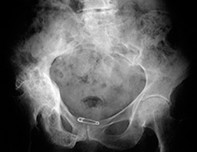Peer Reviewed
Feature Article Rheumatology
Diagnosis and current management of Paget’s disease of bone
Abstract
Paget’s disease of bone is the most common metabolic bone disorder after osteoporosis. The potent new bisphosphonates offer opportunities to suppress disease activity and may have a role in reducing associated morbidity – even in asymptomatic patients.
Key Points
- Paget’s disease affects about 5% of the overall population with a slight male predominance. Between 12 and 40% of patients with Paget’s disease of bone have at least one affected first degree relative.
- Measurement of total serum alkaline phosphatase is a simple and sensitive screening test that can also be used to monitor therapy. Screening should be considered in family members with unexplained musculoskeletal symptoms.
- In asymptomatic individuals, Paget’s disease may be diagnosed either as a result of an elevated alkaline phosphatase finding or as an incidental finding on radiographs.
- Bisphosphonate therapy is now regarded as the treatment of choice for symptomatic patients. Potent oral agents taken for three to six months produce long term suppression of disease activity.
- Symptomatic disease and preparation for orthopaedic surgery are major indications for bisphosphonate therapy, with potent oral agents offering the potential to modify the course of the disease.
- Asymptomatic individuals who have involvement at sites that may be prone to complications should be referred for an opinion regarding use of antiresorptive therapy.
Purchase the PDF version of this article
Already a subscriber? Login here.

